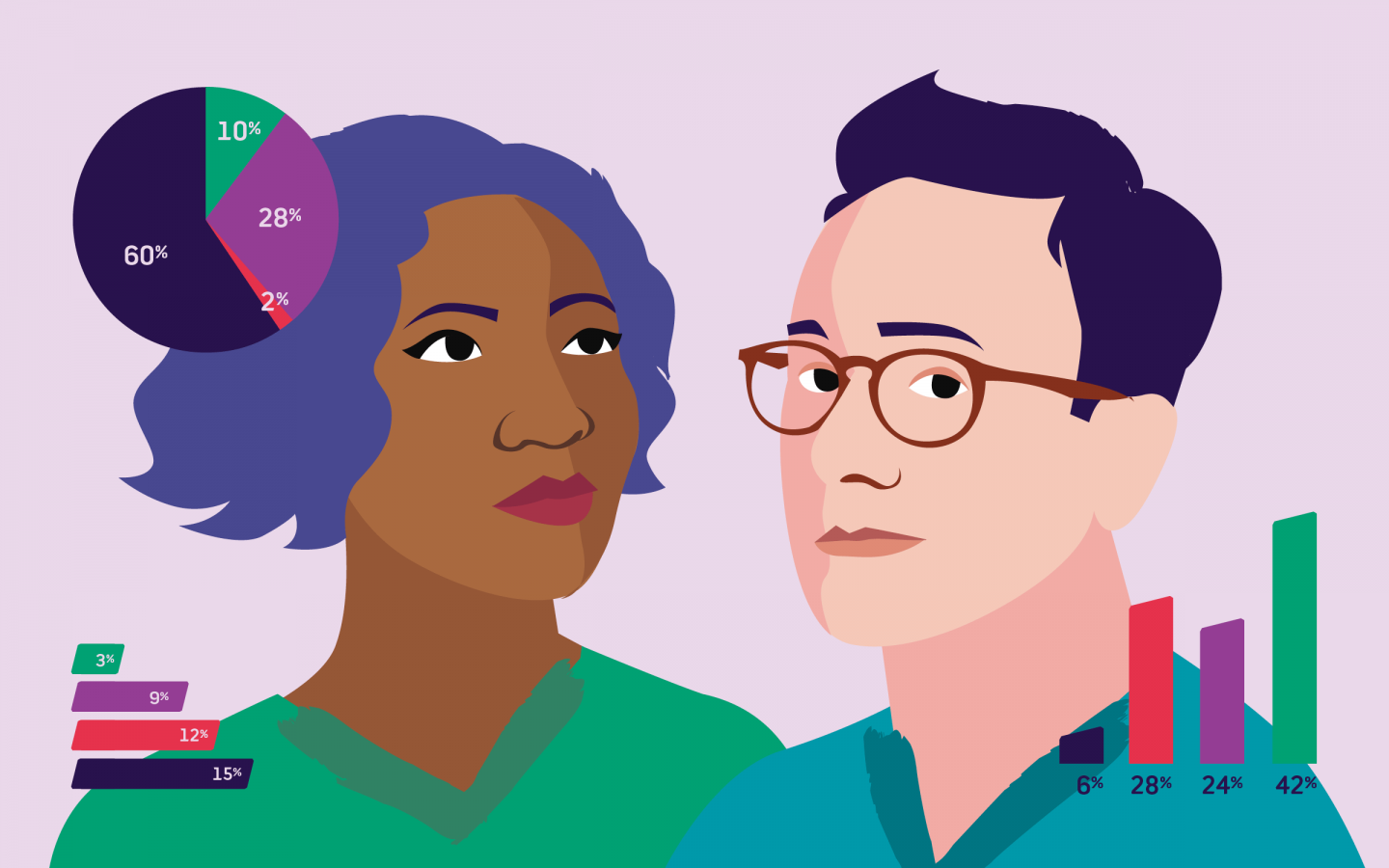Here are the highlights from our survey of 750 nurses across the country—for a more in-depth look at the data and findings, download the full report.
What we researched and why
In late 2019, the World Health Organization designated 2020 as the “International Year of the Nurse and Midwife.” It was a year that was supposed to truly celebrate nurses, and not with token gestures like pizza parties. Of course, there was no way to predict how the year would actually unfold for us—Nurse Nacole put it best in our very first episode of SHIFT Talk when she described 2020 as “the test you never knew was coming.”
As nurses, survival is in our DNA. There’s no question we passed the test—we’re still passing it every day. But what SHIFT wanted to understand is what this has cost us. We wanted to know more about how the pandemic has affected nurses as a group.
So we partnered with the Robert Wood Johnson Foundation to deploy a national survey of everyday nurses and ask them how they’ve been impacted by the pandemic.1
THE NURSES WE SURVEYED AND HOW WE DID IT
We surveyed 750 U.S. nurses from November 11-20, 2020. It was important to us to survey a sample that truly represented the diversity of the profession—with representation across multiple work settings, the actual gender breakdown within nursing and the diversity of racial/ethnic backgrounds among nurses. The survey (slightly) oversampled long-term care nurses because we wanted to understand more than what we saw in the montage of media stories about nursing homes during the pandemic.
The point of this report is not to speak over any of your individual experiences, but rather to share some dominant themes we saw and ask you, our beloved SHIFT Talkers, how these findings do—or do not—fit with your experiences.
What we heard:
SIX KEY THEMES FOR CONSIDERATION IN 2021
This survey was conceived under the weight of hundreds of news stories and firsthand accounts of nurses experiencing the pandemic from the front lines— including some of the stories we featured last year on SHIFT Talk. We knew that many nurses were dealing with insufficient PPE, overwhelmed ICUs, and the mental burden of serving as surrogate family members. What we didn’t know as much about was the day-to-day impact of working during a pandemic.
Six key themes emerged from this research:
- COVID-19 is taking a real toll, not just on the job, but off the job
- Stress and burnout are both common, but nurses are not experiencing them evenly
- Many nurses are considering a change in career—whether that’s leaving the bedside, retiring early, going back to school, or something else entirely
- How can we effectively address the “isms” (racism, ageism, sexism) if we’re still eating our young?
- What’s going on in long-term care?
- Nurses, as a group, are interested in new and expanded roles outside traditional healthcare settings
THEME #1
COVID-19 is taking a real toll, not just on the job, but off the job
We actually saw that the pandemic is taking just as high a toll, if not higher, off the clock. The vast majority of nurses (74%) have worried about their work making their family sick.
The number of nurses with financial worries related to the pandemic is also notable—it’s nearly half (44%) of those surveyed, with a third of nurses identifying themselves as the sole provider for their families.
So how do you sleep at night, when you’re scared your job will make your family sick, but you also rely on it to provide for your family?
THEME #2
Stress and burnout are both common, but nurses aren’t experiencing them evenly
Among the hundreds of nurses surveyed, 41% said that they were “burning out” or “completely burned out.”
No surprise here, SHIFT Talkers, except maybe that the numbers weren’t even higher. Perhaps that’s a sign that we nurses have learned to compartmentalize well. Because burnout has long plagued this profession.
The majority of nurses (81%) reported feeling stressed. Interestingly, they rated their stress as mild to moderate, with just one in four reporting severe or extreme stress. This caused us to pause and wonder because we’d bet the number wouldn’t be that different among other professions who aren’t risking their life and seeing death daily.
Is it really that nurses aren’t stressed, or is it that we’ve just gotten so good at pushing down our feelings to do what we need to do that we’re not emotionally tuned in? Is there a silent cost to our toughness and stress tolerance?
THEME #3
Many nurses are considering a change in careeR
Almost exactly half of these nurses said that they were likely to take a nursing job away from the bedside, and more than a third said that they were likely to retire sooner. Uh oh.
Smaller percentages answered that they would go back to school or exit the profession altogether. While that’s somewhat reassuring, the big picture is disheartening—a lot of nurses are looking toward the exit sign. And that’s on top of our Boomers, whom we know will be exiting the workforce in the next few years regardless of the pandemic.
But here’s the strange thing, the thing we might need your help sorting: Three in four nurses surveyed were still likely to recommend someone enter the field of nursing. What’s the takeaway here? We are hurting, but we still want to help? We are hurting, but we still have hope?
THEME #4
Can we effectively address the “isms” (racism, ageism, sexism) if we’re still eating our young?
When we asked nurses if they believe they were being treated unfairly due to their sexual orientation, racial/ethnic background, gender, or age, the highest percentage (15%) reported that they were treated unfairly due to their age (although actually what we’re talking about is years of experience). For those with less than 5 years of work experience, the percentage was even higher—33%.
What’s really interesting is that bias based on other factors lags behind—which surprised us, because we’ve heard lots of stories and seen some data that contradicts this trend.
THEME #5
What’s going on in long-term care?
We slightly oversampled for long-term care nurses, because we’re so interested in understanding what’s actually behind the montage of media stories about COVID-19 in this healthcare setting.
Here’s what we learned: the nurses who work in this setting were less likely to consider COVID-19 a major threat to public health, with about a quarter (23%) describing it as just a “minor threat” and a small group (4%) calling it “not a threat” at all. Wow, with the number of deaths of nursing home residents due to COVID-19, that surprised us!
Can any of you SHIFT Talkers in LTC help us understand this perspective?
THEME #6
Nurses are interested in roles outside traditional settings
We asked nurses about community health, and the results were inspirational—and not at all surprising, given the global pandemic and the critical role nurses have played in it. A majority (83%) said they played a role in preventative health in 2020, compared to just over half (57%) in 2019.2
But here’s the rub—and this won’t be news to most of you—these nurses pointed to “getting pulled in too many directions/accountable to too many people already” as a limiting factor in playing bigger roles in community health.
Are any of you wondering, why is community health on us?
SO WHAT, SHIFT? WHY SHOULD THIS MATTER TO ME?
We know that these data points don’t tell the whole story—we also know that all the views expressed in this survey will be skewed to a degree by the fact that the people sharing them are also responsible for managing a global pandemic. You are managing a global pandemic.
Most healthcare settings and healthcare providers are still laser-focused on COVID-19, whether it’s the virus itself or dispensing the vaccine or educating the public. And that’s the way it should be.
But what we hope is that in the “in between” moments— when you have a minute alone to scroll through social, a 10-minute break to grab a coffee with your SHIFT BFF, or whatever else it is that fills your mental cup—that you think about what we learned about you as a group. And ask the tough questions. Ask yourself, ask us, ask your peers.
To join the conversation, like us on Facebook and follow us on Instagram—we’ll be posting content related to this survey to both platforms. Or, drop us an email at hello@shiftnursing.com


